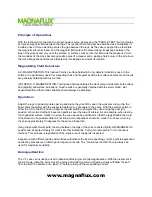
www.magnaflux.com
Principle of Operation:
With the instrument connected to a proper power source, depressing the "PUSH to TEST" switch creates
an intense magnetic field between the legs. The resultant field can best be described as a multiplicity of
invisible lines of force extending across the gap between the legs. As the yoke is applied to a steel plate,
the magnetic circuit is closed, and the magnetic field enters the plate making its passage between the
legs of the yoke at and very near the surface. A surface crack across this field cuts the magnetic circuit;
the two sides of the crack become opposite poles of a magnet and a leakage field occurs in the air above
the crack. Magnetic particles are attracted by this leakage and mark its location.
Magnetizing Field Selection:
A.C. MAGNETIZATION-This induced field is a surface field which only detects indications open to the
surface. It is particularly useful for inspecting thick and irregular sections for surface defects. Good results
are generally obtained with dry method.
(PULSED) D.C. MAGNETIZATION-This induced field penetrates the work piece and detects both surface
and (slightly) subsurface indications. Good results are generally obtained with the wet method. But
experimentation with method variables should always be practiced.
Operation:
Adjust the legs to an appropriate spacing and place the yoke firmly upon the work piece (securing the
best contact possible) with the suspected defect at a right angle to the poles. With the selector switch in
either the AC or the DC position, depress the test switch to energize the yoke and lightly dust (dry
powder) or flow (wet method) inspection particles over the area of interest. As an example, when testing
for longitudinal surface cracks in a weld, the yoke would be positioned so that the legs straddle the weld.
If the direction of a possible defect is not known, two inspections should be made in such area, turning
the yoke approximately 90 degrees for the second inspection.
Using the powder blower bulb, the area between the legs of the yoke is dusted lightly with MAGNAFLUX
powder and inspected closely for cracks or other indications. Current should remain "on" (continuous
method). This process is repeated until the entire area of the part is inspected.
Experience with different parts and surfaces will indicate the best magnetizing current, particle application,
and testing procedures to obtain good inspection results. The "continuous method" should always be
used for maximum sensitivity.
Demagnetization:
The Y-7 yoke can usually be used to obtain satisfactory level of demagnetization. With the instrument in
the AC mode, place the part across the poles and while the current is flowing slowly withdraw the part
from the field to a distance of a least 18” before turning off the magnetizing current.





















